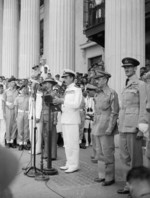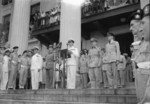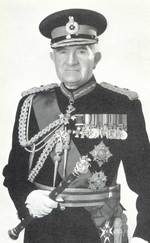William Slim
| Surname | Slim |
| Given Name | William |
| Born | 6 Aug 1897 |
| Died | 14 Dec 1970 |
| Country | United Kingdom |
| Category | Military-Ground |
| Gender | Male |
Contributor: C. Peter Chen
ww2dbaseWilliam Joseph Slim was born in Bristol, England, United Kingdom to John Slim, an ironmonger, and Charlotte Tucker. He was educated in Birmingham, England, and joined the British Army at the beginning of WW1 in 1914. He was quickly promoted to lead the Royal Warwickshire Regiment. He was seriously wounded at Gallipoli, Turkey and was medically discharged, but he managed to convince the British Army to allow his return. He saw more action in Palestine before the war ended, where he sustained more injuries. He earned the Military Cross for his contributions to Britain during WW1. After the end of WW1, he was made a temporary major and was assigned to the 6th Gurkha Rifles regiment in India. In 1926, he married Aileen Robertson, with whom he would have two children, a son and a daughter. Later in the same year, he attended the Quetta Staff College in India. In 1933, he was promoted to the permanent rank of major. Between 1934 and 1937, he was an instructor at Camberley Military College in Britain. In 1938, he returned to India with the rank of lieutenant colonel to lead the 2nd Battalion of the 7th Gurkha Rifles regiment. In Jan 1939, as a permanent colonel and temporary brigadier, he was posted to the Senior Officers' School at at Belgaum, India.
ww2dbaseThroughout the inter-war years, Slim found his wages as an army officer to be inadequate in supporting his family. He wrote many novels under the nom de plume Anthony Mills.
ww2dbaseAt the start of WW2, Slim was assigned the 10th Brigade of the Indian 10th Infantry Division as the brigade commander; in this role he fought in Sudan, British East Africa and in Abyssinia, Italian East Africa. He was wounded in Jan 1941 early in the action, and thus missed most of the campaign in Africa. While in Africa, he met Major Orde Wingate, whom he would later work with closely in Burma. After his recovery, he held the rank of major general and served in Syria and Iran. In Mar 1942, he was promoted to the rank of Lieutenant General and assigned responsibility of Burma Corps to defend Burma against the Japanese invasion. By the time he was assigned this task, the capital Rangoon was already being threatened by the Japanese. Along with General Harold Alexander, he withdrew into India after fighting a hopeless delay-action campaign. Upon reaching India, he assumed command of XV Corps for the defense of India.
ww2dbaseIn summer 1943 Slim led an attack into western Burma in attempt to capture Akyab, but the campaign ended in failure. He was relieved of his duties when Lord Louis Mountbatten came into the theater to take on the role as the British commander of the theater, and was given commission of the British 14th Army. In Mar 1944, he successfully defended Assam against the Japanese Army, then on 20 Mar 1945 he successfully recaptured Mandalay. Before the war ended, he became a full general and the Commander-in-Chief of Allied Land Forces in Southeast Asia.
ww2dbaseAfter the war, Slim became the head of the Imperial Defence College, then in 1948 he was named Chief of the Imperial Staff. He was promoted to the rank of Field Marshal in 1949. He served as Governor General of Australia between 1953 and 1960; during his tenure in Australia he published his memoirs in 1959 under the title Unofficial History. He was made Knight of the Garter and Viscount in 1960. He passed away in London, England.
ww2dbaseSources:
Frank McLynn, The Burma Campaign
Nathan Prefer Vinegar Joe's War
Last Major Revision: Oct 2005
William Slim Interactive Map
Photographs
 |  |  |
William Slim Timeline
| 6 Aug 1897 | William Slim was born in Bishopston, Bristol, England, United Kingdom. |
| 19 Mar 1942 | Lieutenant General William Slim was ordered to lead the Burma Corps. |
| 15 Apr 1942 | Alexander, Slim, and Stilwell met at Maymyo, Burma. |
| 19 Apr 1942 | Slim, Wavell, and Alexander met to start discussing plans for a major retreat of Allied personnel out of Burma. |
| 1 May 1942 | Slim met with Alexander at Monywa, Burma. |
| 5 Apr 1943 | William Slim and Noel Irwin met in Calcutta, India. |
| 16 Oct 1943 | Louis Mountbatten named William Slim the commanding officer of the new 14th Army. |
| 22 Oct 1943 | Louis Mountbatten met with William Slim for the first time at Barrackpore in eastern India. |
| 22 Mar 1944 | William Slim met with Orde Wingate. |
| 3 Apr 1944 | General Montagu Stopford ordered Major General R. P. L. Ranking to move the Indian 161st Brigade from Kohima to Dimapur in India. Ranking believed this was a bad move as Kohima would be a Japanese target, and appealed to William Slim; Slim sided with Stopford. Also on this date, Louis Mountbatten and William Slim met with Joseph Stilwell at Jorhat, an airfield at Assam, India; Stilwell reluctantly offered to send Chinese 38th Division to Imphal, India to assist with the defense, and was secretly relieved when Slim declined as Stilwell wished to use the Chinese in northern Burma to further his own campaign |
| 17 May 1944 | The Japanese attack on the Blackpool site of Operation Thursday in Burma was repulsed. On the same day, William Slim handed operational control of the Chindits over to Joseph Stilwell. |
| 1 Jun 1944 | In his diary, William Slim privately complained of Louis Mountbatten's lack of vision and Henry Pownall's laziness. |
| 8 Nov 1944 | Louis Mountbatten freed William Slim the responsibility in the Arakan region of Burma so he could focus on northern Burma. Additionally, Slim was also given the Indian 25th Division and the West African 2nd Division. |
| 14 Dec 1944 | By special permission of King George VI, Lieutenant General William Slim was knighted in a ceremony at Imphal, India by Field Marshal Archibald Wavell in the presence of Vice-Admiral Louis Mountbatten. |
| 7 May 1945 | Oliver Leese told William Slim his intention to transfer Slim to the British 12th Army for the occupation of Burma. Deprived the command to lead the invasion into Malaya, Slim told Leese that he would rather retire. |
| 9 May 1945 | William Slim indicated to his senior staff at the British 14th Army that he might soon be sacked by Oliver Leese. The senior staff officers leaked out the news. |
| 29 Jun 1945 | Winston Churchill and Alan Brooke dismissed Oliver Leese and promoted William Slim to the rank of full general to succeed Leese as Commander-in-Chief, Allied Forces, South-East Asia. |
| 14 Dec 1970 | William Slim passed away in London, England, United Kingdom. |
Did you enjoy this article or find this article helpful? If so, please consider supporting us on Patreon. Even $1 per month will go a long way! Thank you. Share this article with your friends: Stay updated with WW2DB: |
Visitor Submitted Comments
30 Mar 2007 04:56:24 AM
I think you have skimmed over Slims achievements in Burma. He took a defeated army and turned it into one of the greatest fighting forces of the war. His handling of the battles of ImphalKohima showed that he had mastered the art of defence his complete unhinging of the Japanese positions in central Burma in 1945 with the attacks on Meiktila and Mandalay showed that he had completely mastered the art of armoured warfare. This coupled with the innovations that he introduced of air mobility shows that he was a commander of the highest order. he was, probably, the finest British commander of the war and one of the finest ever.
3 Aug 2008 08:48:17 PM
Sir,
You do both Bill Slim and the 14th Army an injustice. I am in agreement with the above comments and would add that you have forgotten the Battle of Imphal which cracked the Japanese open for the advance.
Do not rely too highly on Joseph Stillwell as an uninterested observer his theatrics did no one any good.
12 May 2016 02:31:45 PM
So you say 'Slim withdrew into India after fighting a hopeless delay-action campaign against the British in Burma"
Are you sure about that?!! Against the British~ surely you mean 'against the *** '!!!
13 May 2016 05:37:53 AM
Robin Sanderson: Thanks for pointing out the error -- and quite a silly one at that. The text has been corrected.
15 Dec 2017 12:54:52 PM
Slim tried and tested new jungle warfare techniques before Imphal. He tested these techniques at The Battle of The Admin Box in February, 1944. Without this encounter with The Japanese The Battles of Koheima and Imphal would have been more disastrous than they were. Do not forget this Battle folks..it was a turning point for SEAC.
All visitor submitted comments are opinions of those making the submissions and do not reflect views of WW2DB.
» Invasion of Burma
» Battle of Meiktila-Mandalay
» Battle of Rangoon
Related Books:
» The Burma Campaign: Disaster into Triumph 1942-45
- » 1,150 biographies
- » 337 events
- » 44,024 timeline entries
- » 1,242 ships
- » 350 aircraft models
- » 207 vehicle models
- » 375 weapon models
- » 123 historical documents
- » 260 facilities
- » 470 book reviews
- » 28,622 photos
- » 431 maps
Chiang Kaishek, 31 Jul 1937
Please consider supporting us on Patreon. Even $1 a month will go a long way. Thank you!
Or, please support us by purchasing some WW2DB merchandise at TeeSpring, Thank you!
15 Jul 2006 03:40:10 PM
Mr Peter Chen.Your summary of William Slim although mainly accurate has a few flaws and soils the name of what many Military Historians consider the best field commandor of the 20th century.
Slim did not lead an attack on Akyab in thr Arakan region of Burma in fact he advised against it.He was blamed for the debacle by his CO General Noel Irwin.However good sense prevailed and Irwin was sacked and slim retrived the situation with an orderly retreat.Mountbatten never took Slims place he was sent by the Allied commanders as head of SEAC (South East Area Command)Slim took Irwins position and reformed the Burma army into the Fourteenth Army which inturn became to quote Williamson Murray (Professor of Military History at Marine Corp University)an army both tacticaly and operationaly met a standard that only the best of German troops equaled.
Andrew Pozniak